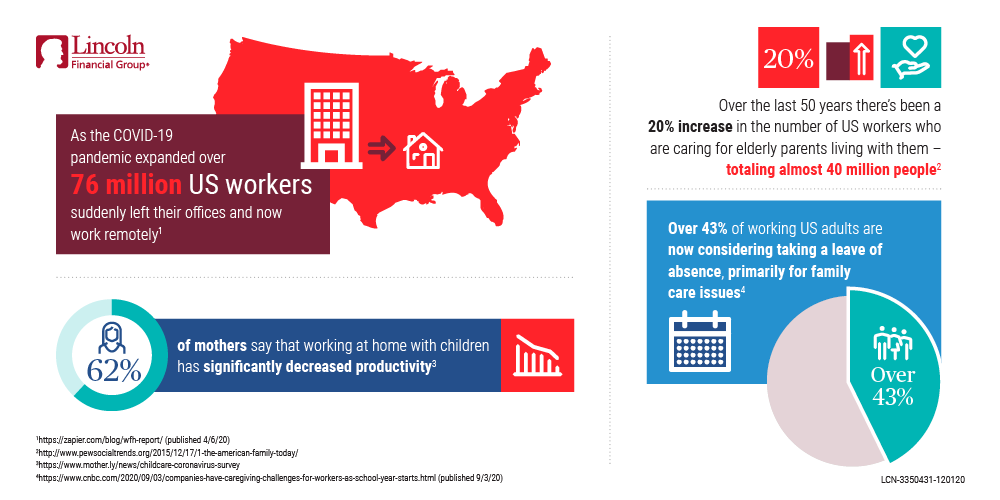As leaders, you play a key role in encouraging employees to prioritize their mental health.

To support you through these challenges, Lincoln Financial is sharing an article authored by Dr. Glenn Pransky, MD Associate Professor University of Massachusetts Medical School and Scientific Advisor to Lincoln, which acknowledges the difficulties employees may be experiencing when working from home while caring for others.
***
As the COVID-19 pandemic expanded, over 76 million U.S. workers suddenly left their offices and are now working remotely.1 With school and day care closures, at least 35% are also caring for children at the same time.2 Adults worried about the safety of elderly parents in nursing and retirement facilities have brought them home to care for them. And they are doing it alone because of COVID concerns.
Despite this shift to at-home care, there’s been a 40% drop in usage of home care workers.3 These recent changes are dramatic, but these trends aren’t new. Over the last 50 years, there’s been a 40% growth in single-parent and two-earner households, increasing the need for child care. And, over the same time, there’s been a 20% increase in the number of U.S. workers who are caring for an elderly parent living with them — totaling almost 40 million unpaid caregivers.4
The Challenges of Working While Caregiving
Trying to work at home while caring for children and elderly parents creates several challenges. Many at home workers cite lack of commute, flexibility and ability to work without interruptions as pluses of this new work arrangement.5 But some negative aspects are also common — loneliness, loss of normal routine, isolation from co-workers, lack of supervision and feedback, expectations of being always available, working longer hours, discomfort from poor workstations and feeling burned out.6 7 Simultaneous child or elder care creates additional challenges while working from home — interruptions, work disorganization, family conflicts and worries about family safety.

The stresses of at-home caregiving can cause poor physical and mental health, weight gain and adverse lifestyle changes in the caregiver.8 Trying to work at home at the same time increases these negative impacts.9 10 Work output can also suffer as 62% of mothers say that working at home with children has significantly decreased their productivity.11 Thus it’s no surprise that over 60% of those in a recent survey who are simultaneously working and caregiving worry about whether this is sustainable for the long-term.12 As a result, over 43% of working U.S. adults are now considering taking a leave of absence, primarily for family care issues.13
These trends are worrisome for employers struggling to get back to full operations; some estimate that each day of unscheduled worker absence costs employers up to three times the wages they would’ve paid the missing employee.14 And distractions at work (for those in the workplace) due to caregiving issues also exacts a significant toll on productivity.15
However, employers find that they can make a significant impact in preventing some problems caused by trying to work and provide care at home.
Helping Employees Find Balance
The first step is to acknowledge that these are difficult challenges, show sincere concern and offer specific actions to help working caregivers. Even if solutions are not yet in place, encouraging an open dialogue among employees about caregiving issues reduces stress on employees who think they need to hide their multiple responsibilities from their co-workers and pretend it’s “business as usual.”16
Employers also should set clear expectations and offer suggestions about working at home.17 18 Encourage employees to separate “work” from home life as much as possible—with a dedicated work space (with a good ergonomic setup), and specific work hours. Recommend a routine that’s conducive with productive work.19 And it’s helpful to pay extra attention to keeping everything organized, as there’s often more potential for disorganization at home.20 Discourage them from trying to be available 24/7—burnout is less likely if employees follow predictable and reasonable work hours, and take time off from work. This means turning off email and text notifications that aren’t emergencies.21 Managers also should respect these boundaries.22
Setting expectations and a routine for the entire family can be very helpful. Encourage employees to set and maintain consistent boundaries about when they are and aren’t available to others in the household, and what they can and can’t do during work time. This clarity and separation makes the transition from work to home life easier for everyone.23 Offer strategies for working at home with young children nearby that may include setting expectations, making calls during quiet time, finding engaging activities for children, and having a contingency plan for the unexpected.24 25 26 27
Since the onset of the COVID-19 pandemic, many employers have offered a variety of new leave, flexible work and shared job options to provide the flexibility that employees need to care for family members at home.28 And, more are transitioning to providing services that help solve a caregiving problem instead of taking leave. These include discounted child care, subsidized tutoring for homebound school-age children, reimbursement for backup elder care, help for setting up caregiving arrangements and other alternative reimbursement strategies for caregiving.
Stay connected
Local agencies often support at-home elders with community engagement, at- home meal delivery and health checks.29 30 AARP has a helpful weekly webcast about elder care at home. Often, unexpected resources appear, such as high school students available in the afternoons, informal community day care collaboratives, partnering with two or three other families and local support groups of at-home working parents.31
Supervisor support and regular check-ins are more important than ever. An open dialogue about challenges balancing work and caregiving at home can identify problems and potential solutions.32 Some employers have instituted virtual daily group huddles. They encourage employees to share their actual experiences working at home, positive and not so great, and create a culture of accepting that it’s OK if this is challenging and doesn’t go perfectly.33
Keeping a focus on improvement instead of perfection should apply to both work and home life.34 Encourage co-worker connections and support. It’s too easy for this to fall off without in-person connections.35 Taking breaks and getting outside can help reduce stress. Remind employees to take care of their own physical and mental health.36
Supervisors can look for signs of increased stress and anxiety, and encourage employees to use available resources—such as the employee assistance program, local elder care and social service agencies, and talking with other employees facing similar challenges. Discussing these issues with others and looking for solutions outside the home help reduce stress and anxiety.37
These are challenging times for everyone—especially for those trying to work while caring for their families at home. Employers who acknowledge difficulties, offer solutions and use employee feedback to adjust course will have workers who are less stressed, more productive and more likely to stay on the job— regardless of where they are working.
If you want to read more COVID-19 tips for your workforce, click the button below.
***
Resources:
- https://zapier.com/blog/wfh-report/ (published 4/6/20)
- https://www.brookings.edu/research/working-parents-are-key-to-covid-19-recovery/ (published 7/8/20)
- https://www.washingtonpost.com/ (published 3/23/20)
- http://www.pewsocialtrends.org/2015/12/17/1-the-american-family-today/
- https://zapier.com/blog/wfh-report/ (published 4/6/20)
- https://www.theguardian.com/money/2020/jul/14/end-of-the-office-the-quiet-grinding-loneliness-of-working-from-home
- https://www.forbes.com/sites/onemind/2020/03/17/when-home-becomes-the-workplace-mental-health-and-remote-work/#54f799ab1760 (published 3/21/20)
- Fuller-Tyszkiewicz M, Richardson B, Little K, et al. Efficacy of a Smartphone App Intervention for Reducing Caregiver Stress: Randomized Controlled Trial. JMIR Ment Health. 2020;7(7):e17541. (published 7/24/20)
- https://www.agingcare.com/articles/the-sandwich-generation-caring-for-children-and-elderly-parents-123286.htm (published 9/5/20)
- https://www.livescience.com/pandemic-work-from-home.html (published 8/17/20)
- https://www.mother.ly/news/childcare-coronavirus-survey
- https://www.pbs.org/newshour/health/this-is-not-working-parents-juggling-jobs-and-child-care-under-covid-19-see-no-good-solutions (published 7/23/20)
- https://www.cnbc.com/2020/09/03/companies-have-caregiving-challenges-for-workers-as-school-year-starts.html (published 9/3/20) For use with the public. ©2020 Lincoln National Corporation LCN-3238964-091120 Resources: Lincoln Financial Group is the marketing name for Lincoln National Corporation and its affiliates. Affiliates are separately responsible for their own financial and contractual obligations. LincolnFinancial.com
- https://www.cnbc.com/2020/09/03/companies-have-caregiving-challenges-for-workers-as-school-year-starts.html (published 9/3/20)
- https://www.aarp.org/caregiving/life-balance/info-2019/caregiving-demands-workplace.html#:~:text=While%20more%20than%20 three%2Dquarters,time%20off%20hurt%20workers’%20careers. (published 1/16/19)
- https://www.aarp.org/caregiving/life-balance/info-2019/caregiving-demands-workplace.html (published 3/16/19)
- https://www.pcmag.com/news/get-organized-20-tips-for-working-from-home (published 7/31/20)
- https://www.buzzsprout.com/847582/3583879 (our Working at home / burnout podcast episode)
- https://www.cnn.com/2020/04/20/success/burnout-work-from-home-wellness/index.html (published 4/20/20)
- https://www.vault.com/blogs/workplace-issues/challenges-of-working-from-home (published 3/30/20)
- https://www.vault.com/blogs/workplace-issues/challenges-of-working-from-home (published 3/30/20)
- https://www.remoteyear.com/blog/avoid-10-mistakes-remote-work-transition (accessed 9/3/20)
- https://www.vault.com/blogs/workplace-issues/challenges-of-working-from-home (published 3/30/20)
- https://www.nationwidechildrens.org/family-resources-education/700childrens/2020/03/working-from-home (published 3/30/20)
- https://www.themuse.com/advice/work-from-home-kids-coronavirus (accessed 9/3/20)
- https://www.thesimpledollar.com/make-money/17-strategies-to-survive-working-from-home-with-children/ (published 12/13/17)
- https://www.verywellfamily.com/tips-for-working-from-home-with-a-toddler-290525 (published 3/13/20)
- https://www.cnbc.com/2020/07/20/only-32-percent-of-employers-have-plans-for-child-care-amid-partial-school-reopenings.html (published 7/20/20)
- https://eldercare.acl.gov/Public/Index.aspx
- https://www.washingtonpost.com/lifestyle/wellness/family-caregivers-seniors-coronavirus/2020/03/23/f7b3f9f4-6c99-11ea-a3ec70d7479d83f0_story.html
- https://www.parents.com/parenting/work/life-balance/how-to-master-being-a-work-at-home-mom/ (published 3/20/20)
- https://www.betterteam.com/how-to-transition-employees-to-working-from-home (published 7/28/20)
- https://www.businessnewsdaily.com/6674-mobile-workforce-challenges.html
- https://www.weforum.org/agenda/2020/03/working-parents-school-closures-coronavirus/ (published 3/18/20)
- https://medium.com/product-storytelling/the-work-from-home-transition-guide-for-leaders-561eb51b6541 (published 3/18/20)
- https://www.agingcare.com/articles/the-sandwich-generation-caring-for-children-and-elderly-parents-123286.htm (published 9/5/20)
- Leng M, Zhao Y, Xiao H, Li C, Wang Z. Internet-Based Supportive Interventions for Family Caregivers of People With Dementia: Systematic Review and Meta-Analysis. J Med Internet Res. 2020;22(9):e19468



